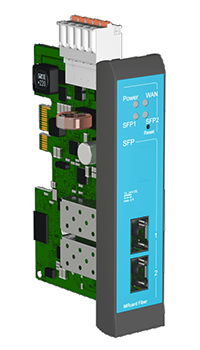Connecting wind farms for remote monitoring
Either offshore or inland, wind farms endure all kinds of harsh environments. Inland, wind farms are exposed to the elements, while offshore turbines operate in highly corrosive conditions where in-person maintenance and repair are hard to conduct. Therefore, as Martin Frederiksen, Managing Director at Recab UK points out, condition monitoring for wind farms is essential and relies upon rugged embedded computing, points out.
With the G7 setting targets of net zero by 2050, the minutiae of exactly how this will work needs to be ironed out. Especially in the UK, the effective use of wind farms will be key to an effective transition to greener sources of energy. However, if rising energy demands are to be met at the same time as this transition takes place, it’s going to be necessary to ensure that the supply of renewable energy can meet the challenge.
An often overlooked aspect of wind farms in the public imagination is the importance of maintenance. Wind farms can be difficult to keep in good condition and sending people out to repair turbines manually is a costly exercise. It’s therefore essential that condition monitoring is as accurate as possible, so as to minimise unnecessary trips for maintenance workers and avert small issues becoming larger problems.
Unlike traditional sources of energy, renewable energy production is often done in small institutions. Grid operators often link these smaller renewable plants into ‘virtual power plants’, but this requires effective communication and reliable monitoring.
Since windfarms are often in more remote locations, such as on the tops of hills or out at sea, most condition monitoring needs to be done remotely. This remoteness can make this data gathering difficult, however. Many cables can only be extended so far. For example, Ethernet cables have a maximum cable range of 500m. This isn’t long enough to cater to the needs of many windfarms, which can be 300km away from the shore.
 Given there are so many issues around cables, why not cut them out altogether? Many engineers have turned to wireless options, such as the MRX industrial routers from INSYS icom. These routers can have their features extended with plug-in cards, such as the MRcard Fiber - in fact, an MRX router with two MRcard Fibers (pictured right) can solve the problem of offshore wind connectivity entirely. These modular plug-in cards connect wind farms using fibre optic technology, meaning that they can stretch over long distances.
Given there are so many issues around cables, why not cut them out altogether? Many engineers have turned to wireless options, such as the MRX industrial routers from INSYS icom. These routers can have their features extended with plug-in cards, such as the MRcard Fiber - in fact, an MRX router with two MRcard Fibers (pictured right) can solve the problem of offshore wind connectivity entirely. These modular plug-in cards connect wind farms using fibre optic technology, meaning that they can stretch over long distances.
The MRcard Fiber features two Gigabit SFPs, as well as two digital inputs, one of which is PLC compatible. One of the digital inputs is low-active, while the other is high-active. While its voltage is supplied via the MRX, there are two further supply connections that can be used, if that becomes necessary.
The MRcard Fiber, along with the other combinable plug-in cards, highlights the core benefit of MRX routers: efficient modularity. The cards eliminate the need for additional devices to be added to the system, reducing costs and making each router easily adaptable to changing requirements. It also helps save space, taking up far less room in automation cabinets, which makes for efficient installation. By using MRcards with an MRX router, systems are future-proofed, as the MRX can be enabled without the hassle of reconfiguring devices.
It’s a challenge for system operators, but with help from technology from INSYS icom, meeting the demands of the renewable revolution becomes a far easier task. As we move towards a future of renewable energy sources, ensuring that remote monitoring is up to the task of keeping everything working also needs to be a priority.





